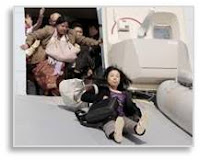 |
| Asiana Crash |
Saturday’s crash of an Asiana Boeing 777 aircraft at San Francisco
International Airport put the issue of air safety back in the news and, more
specifically, highlighted the need for rapid evacuation of passengers. The Wall Street Journal picked up on this
with a story, “Baggage-Toting
Passengers Pose a Risk to Emergency Evacuations,” by Scott McCartney in
which he makes several important points.
The first is that passengers evacuating an airplane should not try to
take their possessions with them. Now,
we are all programmed to gather out things and make sure that we have not left
anything behind when exiting a plane, a train, a bus or any other vehicle other
than our own car. This is a bad idea
when trying to get out of a vehicle that has crashed. In the case of an airplane, exit speed is
particularly important as the craft’s highly flammable jet fuel could
ignite at any time. According to experts, there are
Six Reasons to Leave Your Gear Behind
- Grabbing bags from overhead bins or from under seats takes time that slows you down.
- It distracts you from your immediate need to get out of the plane.
- It clogs the aisles and slows evacuation for everyone else.
- The attendants will make you drop your bag before you hit the slide--which blocks the way for others trying to get out.
- Jumping down a slide will likely jar the bag from your arms and send it flying into someone else.
- You will need your arms and hands free when you reach the slide’s bottom to brace against impact with the ground: it's a fast ride.
 |
| Forget Your Baggage |
The bottom line is that your most important job is to get out of that
plane as quickly as you can and possessions slow you down. The first
90 seconds after a crash are the most important. Your odds of survival will
improve if you can stay calm and move out of the plane quickly. Remember: documents, electronics, credit
cards and money can all be replaced.
Your life cannot.
This may seem like common sense but that rarely applies in an
emergency.
Regular readers of The Next Phase
know that I am interested in the issue of how brains work but I have a
particular interest in the issue of survival.
In an emergency, why do some people live, some people die, and some
survivors simply give up? What causes
Person A to survive while Person B perishes?
Are the causes physical, physiological, emotional, perceptual or based
on training and experience?
There are two excellent books on this subject and they sit side-by-side
on my bookshelf:
Deep Survival: Who Lives,
Who Dies, and Why by Laurence Gonzales.
“Through close analysis of case studies, Laurence Gonzales describes the ‘stages of survival’ and reveals the essence of a survivor—truths that apply not only to surviving in the wild but also to surviving life-threatening illness, relationships, the death of a loved one, running a business during uncertain times, even war.” Mr. Gonzales is contributing editor for national Geographic Adventure magazine and is the author of numerous books.
“Through close analysis of case studies, Laurence Gonzales describes the ‘stages of survival’ and reveals the essence of a survivor—truths that apply not only to surviving in the wild but also to surviving life-threatening illness, relationships, the death of a loved one, running a business during uncertain times, even war.” Mr. Gonzales is contributing editor for national Geographic Adventure magazine and is the author of numerous books.
The Unthinkable:
Who Survives When Disaster Strikes—and Why by Amanda Ripley
“In this inspiring mix of narrative, science and participatory journalism, award-winning Time Magazine writer Amanda Ripley reveals how human fear circuits and crowd dynamics work, why our instincts sometimes misfire in modern calamities and how we can prepare for inevitable calamities more intelligently.”
“In this inspiring mix of narrative, science and participatory journalism, award-winning Time Magazine writer Amanda Ripley reveals how human fear circuits and crowd dynamics work, why our instincts sometimes misfire in modern calamities and how we can prepare for inevitable calamities more intelligently.”
Essentially the first book focuses on the psychological aspects of survival
while the second examines the physiological impact. Both books are highly readable, fascinating
and filled with astonishing stories of real-life catastrophes and survival.
Ms. Ripley calls the need to take your things with you “gathering behavior”
and explains that it is common in life-or-death situations. “Facing a void of
unknown, we want to be prepared with as many supplies as possible. And as with normalcy bias, we find comfort in
our usual habits.” In other words,
people think that “This can’t be an emergency because I’m taking my things,
just as usual.”
 |
| Your Bags Won't Help You |
Normalcy
bias is a form of denial, refusing
to believe the accident is happening. As
Ms. Ripley explains, “We have a tendency to believe that everything is OK
because, well, it almost always has been before.” Denial is powerful but it can also be
deadly.
John Hansman, director of the International Center for Air
Transportation, told USAToday that one
reason so many passengers survived the Asiana crash was their ability to get
out of the airplane quickly. "If people had dawdled getting off this
airplane, that would have put them at increased risk," he said. FYI: “Increased risk” is a euphemism for staying
on the plane and dying.
When it comes to survival, particularly airplane crashes, there are simple--but important--things to know and to do. The
most important thing though, is to not assume that this trip will be as safe as
every trip before it has been. Preparing
for the worst won’t make a disaster happen but it may help you survive
one.
More on this later.


No comments:
Post a Comment